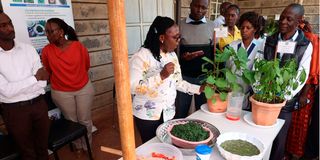
Dr Anne Aswani Musotsi,a lecturer of nutritional sciences at Masinde Muliro University of Science and Technology, speaking at Githunguri Level V hospital in Kiambu County on June 24, 2025, during the African Indigenous vegetables in Urban Agriculture meeting for teenage mothers. EVANS HABIL|NATION.
Kenya exports about 5 per cent of locally grown and produced African Indigenous Vegetables (AIVs), which means 95 per cent is consumed locally. Some common examples include Amaranthus (Terere), Spider plant (Saget/Saga), African nightshade (Managu/Sucha/Osuga), Cowpea leaves (Kunde), Jute Mallow (Mrenda/Murere), and Pumpkin leaves. They are popularly called mboga kienyeji.
“People are gradually becoming cautious of lifestyle-related diseases and are turning to organic food, such as traditional vegetables, to boost their health,” says Dr Anne Aswani, a nutritionist from Masinde Muliro University of Science and Technology.
Even though indigenous vegetables are mainly grown in rural areas, with Western, Nyanza, and Kisii regions leading in production, Dr Anne observes that urban areas record the highest number of consumers.
Previously, these vegetables were mostly found in outdoor and open-air markets, but today, the delicacies are sold in supermarkets. The shelves are emptied pretty fast in the evening as people aim to get their daily dose of leafy greens.
However, as the demand skyrockets, Dr Aswani regrets that the consumers, especially millennials and Gen Zs, do not know how to prepare and cook these vegetables.
“Previously, knowledge was passed down by word of mouth — from mothers to children, grandmothers or aunties to the young ones. Nowadays, children spend more time in school and do not get time to be taught how to cook the indigenous greens,” she observes.
So, how should these vegetables be prepared and cooked?
“ Indigenous vegetables should be cooked and served green. They should not be overcooked.”
Dr Aswani recommends cooking them within the shortest time possible, at most 15 minutes, which includes boiling and frying.
“Some people boil them for 30 minutes using plenty of water. That is a prolonged period, and it depletes the ingredients,” she cautions.
She advices the leafy greens be washed properly them boiled for 15 minutes max. (Optional). Next, chop onions and fry them in oil. Do not let the onions turn brown as that is overcooking them. Then, tomatoes are added. The mixture should be allowed to blend. And finally, add the boiled greens, stirring to mix and setting aside after a few minutes.
In place of cooking oil, Dr Aswani says milk cream can be used to fry the ingredients. Cream is a dairy product composed of the higher-fat layer skimmed from milk before homogenization.
“Traditionally, we are used to cooking oil, but milk cream can also do the job and make the food tasty and delicious.”
Other ingredients that can be added include groundnut paste (powder mixed with some water), or even coconut milk.
To create awareness of the health benefits of indigenous vegetables, Jomo Kenyatta University of Agriculture and Technology (JKUAT), in partnership with Masinde Muliro University, and private partners such as IREN Growthpad Limited and the Local Research Development Institute, are undertaking a program to promote the cultivation and consumption of the vegetables, with a key focus on farmers and teen mothers.
The project, dubbed National Research Fund (NRF) Upscale African Indigenous Vegetables (AIVs) Climate Smart Technologies for Food and Nutrition Security in Kenya, seeks to upscale production, preservation, value addition, cooking using standardised recipes and how to use technology to grow these vegetables. The initiative is running in two counties, Kakamega and Kiambu.
Recently, the two learning institutions, in collaboration with the key partners, held a cooking workshop at Githunguri Sub-County Hospital, in Kiambu County. Sheila Akinyi Odero, a 19-year-old mother of one, was among the attendees of the event.
“I am passionate about African Indigenous Vegetables, but I did not know some of the ingredients to make them tasty, like groundnuts and even adding plain yoghurt.”
Traditional vegetables come in different varieties, and Sheila admitted that she learned at the workshop that Jute Mallow (Mrenda) comes in different species.
Studies show that indigenous vegetables are rich in Vitamin C and A, proteins, microminerals such as Iron, phytochemicals — antioxidants that cleanse body systems, fiber, carbohydrates, among other nutritional benefits.
“Most young people, especially teen mothers, do not know how to cook these greens. The project seeks to teach them how to grow the vegetables and prepare the delicacy meal,” states Prof Mary Abukutsa from JKUAT’s Department of Horticulture and Food Security, who is the principal investigator of the NRF Upscale AIVs Climate Smart Technologies for Food and Nutrition Security in Kenya project.
With a key focus on the youthful generation, Dr Aswani, who leads Objective 3 of the initiative, which includes the use of recipes, standardisation of recipes, and promoting the use of standardised recipes, emphasises the need to document the recipes, targeting the tech-savvy generation that is always.
“We want the recipes to be available to online. The move will help increase consumption, which will enhance demand, translating to money for the growers. When people learn how to prepare the vegetables, the demand goes up, and farmers will produce more,” explains the nutritional expert.




